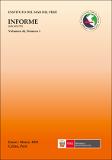Por favor, use este identificador para citar o enlazar este ítem:
https://hdl.handle.net/20.500.12958/3332Registro completo de metadatos
| Campo DC | Valor | Lengua/Idioma |
|---|---|---|
| dc.contributor.author | Flores Castillo, Daniel | - |
| dc.contributor.author | Tejada Cáceres, Alex | - |
| dc.contributor.author | Alarcón Vélez, Julio | - |
| dc.contributor.author | Sarmiento Bendezú, Héctor | - |
| dc.contributor.author | Muñoz, Roger | - |
| dc.contributor.editor | Instituto del Mar del Perú | - |
| dc.date | 2019 | - |
| dc.date.accessioned | 2019-06-17T17:54:22Z | - |
| dc.date.available | 2019-06-17T17:54:22Z | - |
| dc.date.issued | 2019 | - |
| dc.identifier.citation | Inf Inst Mar Perú 46(1), 2019, p. 67-77 | es_ES |
| dc.identifier.isbn | 0378-7702 | - |
| dc.identifier.uri | https://hdl.handle.net/20.500.12958/3332 | - |
| dc.description.abstract | El área de estudio comprendió los límites geográficos establecidos para las islas Ballestas y Chincha en la Reserva Nacional Sistema de Islas, Islotes y Puntas Guaneras (RNSIIPG) además del ámbito marino-costero de las bahías de Pisco y Paracas hasta el río Pisco. Con el objetivo de determinar la distribución y abundancia relativa de los principales recursos costeros en el Sitio Piloto Islas Ballestas del Proyecto GEF PNUD Humboldt se realizó un Estudio de Línea Base (ELBA) entre el 27 de setiembre y 5 de octubre 2013. Del 3 al 8 de marzo 2015 se efectuó un monitoreo en estaciones seleccionadas, mediante muestreos cuantitativos y cualitativos. Se desarrollaron dos métodos de obtención de muestras biológicas, una orientada a peces utilizando embarcaciones cerqueras artesanales y la segunda con embarcaciones pesqueras con compresora, dedicadas a la obtención de recursos bentónicos. Durante el ELBA se recolectaron y analizaron 22 recursos de importancia comercial, correspondiendo 9 al grupo de peces, 8 a moluscos, 2 a equinodermos, 2 a macroalgas y 1 a crustáceo. En el monitoreo del 2015, se identificaron 26 recursos de importancia comercial, perteneciendo 18 a moluscos, 1 a equinodermos, 2 a crustáceos, 3 a peces y 2 a macroalgas. Las zonas que presentaron mayor presencia de recursos fueron islas Ballestas, islas Chincha y Lobería. Entre los recursos que presentaron mayor frecuencia de ocurrencia destacaron Engraulis ringens “anchoveta”, Argopecten purpuratus “concha de abanico”, Thaisella chocolata “caracol”, Aulacomya atra “choro”, Crossata ventricosa “caracol chino”, Transennella pannosa “palabrita” y Cancer porteri “jaiva”. En el análisis de la pesquería se destaca la diversidad de recursos pesqueros; siendo la anchoveta más abundante. | es_ES |
| dc.description.abstract | ABSTRACT:The study area included the geographical limits established for the Ballestas and Chincha islands in the National Reserve System of Guano Islands, Islets and Tips (RNSIIPG in Spanish) as well as the marine-coastal scope of the Pisco and Paracas bays up to the Pisco river. Between 27 September and 5 October 2013, a Baseline Survey was carried out to determine the distribution and relative abundance of the main coastal resources at the UNDP/GEF Humboldt Project Ballestas Islands Pilot Site. From 3 to 8 March 2015, monitoring was carried out at selected stations, by means of quantitative and qualitative sampling. We worked with artisanal purse seiners to obtain fishes and fishing boats with compressor for benthic resources. During the Baseline Study, 22 commercially important resources were collected and analyzed, including 9 fish, 8 mollusks, 2 echinoderms, 2 macroalgae, and 1 crustacean. In the 2015 monitoring, 26 commercially important resources were identified, including 18 mollusks, 1 echinoderm, 2 crustaceans, 3 fish and 2 macroalgae. The areas with the greatest presence of resources were the Ballestas Islands, Chincha Islands, and Lobería. Among the resources that had the highest frequency of occurrence were Engraulis ringens, Argopecten purpuratus, Thaisella chocolata, Aulacomya atra, Crossata ventricosa, Transennella pannosa and Cancer porteri. The analysis of the fisheries highlights the diversity of fishery resources, with the anchoveta being the most abundant one. | - |
| dc.language.iso | spa | es_ES |
| dc.publisher | Instituto del Mar del Perú | es_ES |
| dc.relation.ispartofseries | Informe IMARPE;46(1), 2019 | - |
| dc.rights | info:eu-repo/semantics/openAccess | es_ES |
| dc.rights.uri | https://creativecommons.org/licenses/by/4.0/ | es_ES |
| dc.source | Instituto del Mar del Perú - IMARPE | es_ES |
| dc.source.uri | Repositorio Digital IMARPE | es_ES |
| dc.subject | recursos bentónicos | es_ES |
| dc.subject | Línea base | es_ES |
| dc.subject | monitoreo | es_ES |
| dc.subject | islas Ballestas | es_ES |
| dc.subject | Paracas | es_ES |
| dc.title | Línea base del sitio piloto Islas Ballestas: Recursos pesqueros | es_ES |
| dc.title.alternative | Baseline survey of the Ballestas islands Pilot site: Fisheries resources | es_ES |
| dc.type | info:eu-repo/semantics/article | es_ES |
| Aparece en las colecciones: | Informe vol. 46(1) 2019 | |
Ficheros en este ítem:
| Fichero | Descripción | Tamaño | Formato | |
|---|---|---|---|---|
| Informe 46-1 Línea base del sitio piloto Islas Ballestas.pdf | 1,65 MB | Adobe PDF |  Visualizar/Abrir |
Este ítem está sujeto a una licencia Creative Commons Licencia Creative Commons

